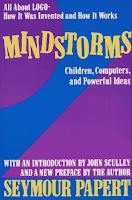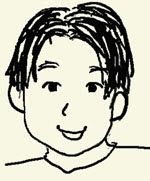
Seymour Papert's book "Mindstorms" has been one of my favorite books ever since I read this book almost 10 years ago. I’ve been fascinated with the philosophy of Papert about learning and education, including key concepts of “object-to-think-with” and “debugging”.
Today, however, I would like to take up another minor parts of this book, but which seems to be important to consider, rather than the explicit key concept as above.
"The idea of programming is introduced through the metaphor of teaching the Turtle a new word." (p.12)
This statement implies quite important thought about the relationship between children and computer agent such as "Turtle" in LOGO. Providing this kind of tools, children can obtain not only tools to manipulate but also "buddy" whom they need to teach. Like a children’s play with dolls, robots, and stuffed toys, children can replace the standpoint between themselves and their computer agent, and empathize with the agent. They can be, so to speak, a big sister or a big brother of the agent.
This situation is very interesting, because children play both roles of "learner" and "teacher" at the same time. Borrowing the phrase of this book, it looks like the situation as follows.
"Novice is not separated from expert, and the experts are also learning" (p.179)
I think that the possibility of this nesting structure of learning and teaching should be considered more seriously.
The thought just described seems be true in the light of my own experience. When I was junior and high school student, I really enjoyed to making programs like games, tools for developing it, and some kind of artificial intelligence. My start point was to make games such as action games to go to a goal, puzzle games including competition with a computer player, and conversation game with computer agent. For me, thinking about the algorithm for thinking of characters in games was really attractive, and I felt that I needed to teach a lot of things for the characters to think and act in their world, which is an artificial world in games. I tried to make them more intelligent to overcome the human players, including me, in order to make the games more interesting and difficult. At that time, I thought of myself as a robot designer like the future-type doctor in cartoon, and was getting to empathize each of computer agents.
With these experiences, I became to read books about Artificial Intelligence and also tips for smart thinking, and implemented it to my computer agents. This was my exploration with "object-to-think-with". Then, as an aside, I studied Artificial Intelligence, especially neural network and distributed AI, when I was university student, and wrote my doctor’s thesis about modeling tools for multi-agent social simulation. Furthermore, I have been teaching complex systems with multi-agent modeling and simulation in university. So I could say that my current profession is based on these experiences. I thus learned a lot from my learning experience with "object-to-think-with".
- Seymour Papert, "Mindstorms: Children, Computers, and Powerful Ideas", Second Edition, Basic books, 1993

You've Got to love this guy!
ReplyDelete""Novice is not separated from expert, and the experts are also learning" (p.179)
ReplyDelete"I think that the possibility of this nesting structure of learning and teaching should be considered more seriously."
You might want to consider reading "Pedagogy of the Oppressed" (1968) by Paulo Freire in which he forwards this idea of conceptual sharing of teacher as student.
Keep up the penetrating insights!